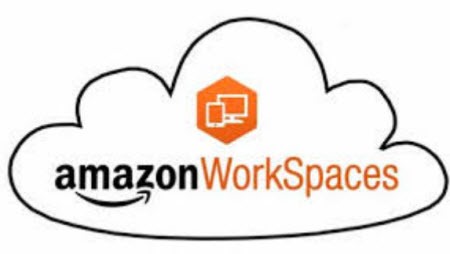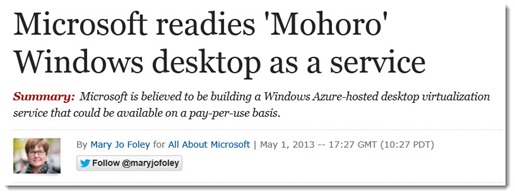Previously:
Looking Forward: Why You Might Never Buy Another Computer
Looking Forward: Computing Without A Computer
Amazon and Microsoft are well along in their plans to offer hosted desktops as a cloud service. In 2014 you will have the option to use a virtual computer to access a copy of Windows with your documents and programs from any device, including tablets.
There are problems to overcome and questions to be answered about availability and security, but the advantages may overcome the initial concerns more quickly than you’d guess. One interesting thing to consider: there are several hundred million Windows XP computers in the world. When Microsoft stops supporting Windows XP in April 2014, those computers will quickly become security risks when they are online and running programs. They are, however, perfectly capable of running a safe Remote Desktop session with one of these new services, which would be the equivalent of replacing them with speedy new computers for far less cost.
AMAZON WORKSPACES: THE FIRST SERVICE OUT OF THE GATE
Last week, Amazon started accepting signups for a preview of Amazon Workspaces, its service for provisioning cloud-based desktops. Amazon will be releasing apps for all platforms – PCs, Macs, iPads, Android tablets, etc. – that will start a session on a remote computer running Windows 7. Amazon Workspaces will be a subscription service that starts at $35/month for a basic PC. Higher prices bring a faster virtual PC with more memory, and the subscription can include Office if you don’t already have a subscription.
From your perspective, these are like any other computer. You can install programs. Files saved on them are actually stored in Amazon’s reliable S3 online storage service, but you’d be able to install Skydrive or Dropbox and sync them to other devices if necessary.
The desktops can be provisioned on the fly for temporary workers, or set up as long-term replacements for office desktops for businesses that are willing to take the plunge. Amazon will be offering various ways to integrate the hosted desktops with on-premises servers, so businesses will not be put in an all-or-nothing position.
You may not appreciate how deeply Amazon has invested in cloud computing. Its Amazon Web Services division is on track to be a $10 billion dollar business by 2015. It provides virtual servers, cloud services, and online file storage to companies around the world. The back-end access to Amazon Web Services is not aimed at end users; it’s for developers and tech people only. But many web sites and online services are built with Amazon Web Services doing the work behind the scenes. Dropbox, for example, stores your files with Amazon’s S3 service. Netflix uses AWS for much of its file storage and streaming. Other services built on AWS: Instagram, Vine, AirBNB, Pinterest, Foursquare, Reddit, Spotify, Bruceb Cloud Backup.
Amazon Web Services has had an even deeper impact in the world of new business startups, especially tech companies, which simply don’t buy any significant amount of hardware any more. Here’s how GigaOM describes it:
“AWS’s impact on startup ecosystem is psychological. Instead of buying hardware and paying for software licenses, a whole generation of companies are growing up with the idea of paying monthly fees for infrastructure, based on usage and demands put on the infrastructure. The idea of buying hardware is anathema to many startups who have grown up with AWS. It continues to have an impact up and down the entire food chain.”
When Amazon starts offering hosted desktops, it has the potential to be a game-changer. The gates will open for a disruptive change in the way we think about our computers.
MICROSOFT IS QUIETLY BUILDING OUT ITS OWN DESKTOP VIRTUALIZATION SERVICE
In May, Mary Jo Foley broke the news that Microsoft is developing its own hosted desktop service, code-named Mohoro, which is scheduled to be unveiled sometime in 2014.
Microsoft Azure is a cloud application platform that rivals Amazon Web Services in its breadth of services. It can be used to host web sites, launch virtual servers, or run web applications. Like Amazon, Microsoft has built up a global network of servers and is courting developers, partners, and businesses with an extensive selection of services designed for flexibility and simplicity.
It is impossible to know how Microsoft will position its hosted desktop service. When Corporate VP Brad Stone responded to Amazon’s announcement last week, he emphasized that Microsoft was building a hybrid solution that would be attractive to larger companies by giving them more freedom to mix cloud resources with their existing infrastructures.
There’s no reason that can’t be combined with a pitch to small businesses and individuals for simple hosted desktops without the complexity of hybrid solutions. Microsoft recently started a long-term shift in the way it sells Office, moving from expensive one-time licenses to long-term subscriptions. It would be bold, indeed, if Microsoft’s new CEO came in and declared that the company was committed to turning Windows into a subscription product. It would change Microsoft’s revenue stream in unpredictable ways, but it might also position Microsoft to extend Windows’ dominance in the world of mobile devices.
Imagine that Microsoft packages up an Azure-based virtual server running one of its small-business oriented Essentials servers, along with fully integrated virtual desktops. Businesses would have their infrastructure needs taken care of with a few clicks of the mouse and a monthly subscription fee. Users could do their work from traditional desktops or from tablets, or from thin clients that haven’t been invented yet. Legacy line-of-business programs could be used on any platform by accessing them through the virtual desktops.
We are on the threshold of a change that might accelerate the decline of the PC industry but extend the life of Windows. Buckle your seatbelts!




